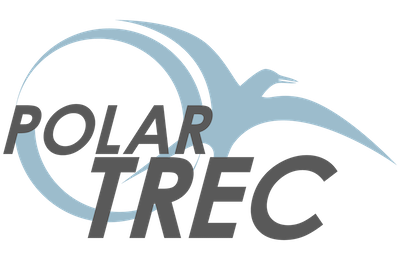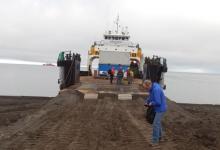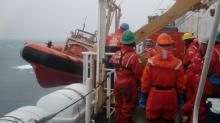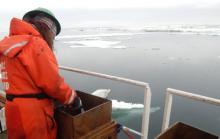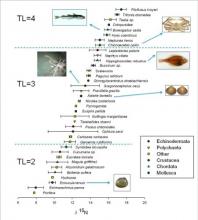What Are They Doing?
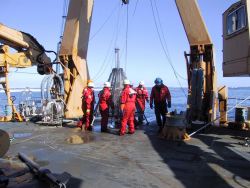 Lowering sampling instruments into the Chukchi Sea
Lowering sampling instruments into the Chukchi Sea
This project attempted to understand the role of carbon resources to the food webs of the Chukchi Sea, off the northwest coast of Alaska. The northern Chukchi Shelf receives large inputs of organic matter transported from the highly productive shelf regions of the North Pacific and from existing sources of primary production, including ice algae, sediment microalgae and phytoplankton. These contributions of highly changing organic carbon, together with potential benthic (from the bottom of the sea) sources of nutrients, likely contribute to the enormous secondary production (production of living material by organisms) of this region. In particular, the relatively shallow depths (40-55 m) and high bottom flow have created "hotspots" of biological productivity found in the vicinity of the Hanna Shoal region of the Chukchi Sea.
The research team included scientists from seven institutions and two federal agencies. The work took place over dozens of existing sampling stations and involved collaboration with other science studies in the region sponsored by federal, state, or industry interests. Due to the biological significance of this region and its importance for oil and gas exploration and development, the group examined the range of biological, chemical, and physical properties that define this ecosystem.
The group focused their efforts on the Hanna Shoal region, with the addition of a pelagic (from the open ocean) component to address standing stocks of phytoplankton and zooplankton, and a physical oceanographic study that addressed water mass movements through direct measurement of circulation, density, and ice conditions.
Where Are They?
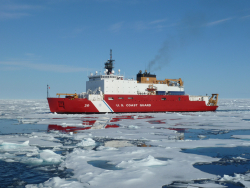 USCGC Healy
USCGC Healy
The team lived and worked on the United States Coast Guard Icebreaker Healy as they traveled off the northwest coast of Alaska to the Chukchi Sea. The USCGC Healy was designed for icebreaking and polar research and can accommodate up to 50 scientists. The USCGC Healy is designed to break 1.2 meters (4 feet) of ice continuously at 3 knots and can operate in temperatures as low as -45 degrees C (-50 degrees F).
Latest Journals

Dr. Kenneth Dunton is a biological oceanographer whose research is focused on estuarine, coastal, and shelf processes. Although his work spans from the Arctic to the Antarctic, his continuous studies of the arctic coastal ecosystem have spanned three decades. Dr. Dunton became involved with arctic studies involving kelp beds in 1977. His research also includes examining the distribution and biomass of benthic biota and the application of stable isotopic signatures to assess changes in trophic structure. Such measurements can help identify processes that are sentinel indicators of global change.
He has continued this work in the Chukchi Sea under funding from the Bureau of Ocean Energy Management (BOEM) and under a grant from the NSF to examine the linkages between watersheds and the nearshore lagoons of the eastern Alaskan Beaufort Sea. Dr. Dunton has published more than 80 peer-reviewed papers and has supervised over 20 graduate students and 11 post-doctoral fellows. He is active in K-12 outreach, obtaining two NSF grants that partner teachers and graduate students in K-12 classrooms. He implemented the annual summer science field program for kids in 2008 in partnership with the City of Port Aransas and the Port Aransas school district. He also implemented a summer science program for the native school children of Kaktovik, Alaska, on the Beaufort Sea coast in conjunction with the Arctic Refuge (USF&WS) that started in 2007. He obtained his BSc in biology from the University of Maine in 1975, his MS from Western Washington in 1977, and his PhD in oceanography from the University of Alaska-Fairbanks in 1986.
Dr. Dunton is currently a professor in marine science at the University of Texas at Austin. He has lived in Port Aransas since he and his wife Susan arrived from Fairbanks in 1986. They have three grown children, two of whom graduated from TAMU College Station and one from UT-Austin. He routinely cycles, surfs and swims. Learn more about Dr. Dunton here and here.
